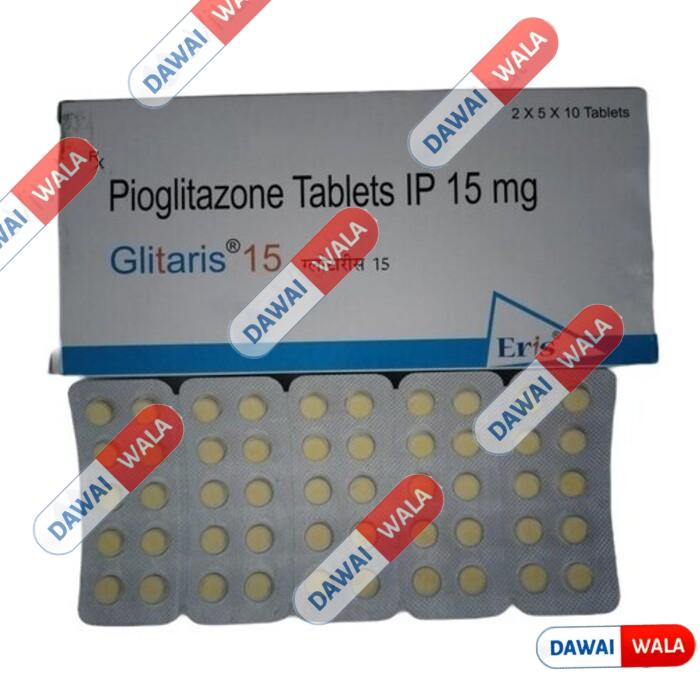

Pioglitazone (15mg)
Glitaris 15 Tablet may be used by itself or along with other medicines. It may be taken with or without food. Take it regularly at the same time each day to get the most benefit. Your doctor will decide what dose is best for you and this may change from time to time according to how it is working.Keep taking this medicine, even if you feel well or your blood sugar levels are controlled. If you stop it without consulting your doctor, your blood sugar levels could rise and put you at risk of kidney damage, blindness, nerve problems, and loss of limbs. Remember that it is only part of a treatment program that should also include a healthy diet, regular exercise, and weight reduction as advised by your doctor. Your lifestyle plays a big part in controlling diabetes.The most common side effects of taking this medicine include headache, sinusitis, muscle pain, and pharyngitis. Consult your doctor if any of these side effects bother you or persist for a longer duration.You should not take it if you have type 1 diabetes mellitus, if you have diabetic ketoacidosis (high levels of acid in your blood), or if you have severe kidney or liver disease. Before taking this medicine, tell your doctor if you have ever had heart disease, thyroid disease, or some hormonal conditions. It may not be suitable. Pregnant or breastfeeding women should also consult their doctor before taking it. Your blood sugar levels should be checked regularly and your doctor may also advise blood tests to monitor your blood cell counts and liver function.
Most side effects do not require any medical attention and disappear as your body adjusts to the medicine. Consult your doctor if they persist or if you’re worried about themCommon side effects of Glitaris
10 tablets
Image shown is a representation and may slightly vary from the actual product. Every effort is made to maintain accuracy of all information displayed.
Take this medicine in the dose and duration as advised by your doctor. Swallow it as a whole. Do not chew, crush or break it. Glitaris 15 Tablet may be taken with or without food, but it is better to take it at a fixed time.
Glitaris 15 Tablet is an anti-diabetic medication. It works by increasing the body's sensitivity to insulin, a natural substance that helps control blood sugar levels.
Related Warnings
It is unsafe to consume alcohol with Glitaris 15 Tablet.
Glitaris 15 Tablet may be unsafe to use during pregnancy. Although there are limited studies in humans, animal studies have shown harmful effects on the developing baby. Your doctor will weigh the benefits and any potential risks before prescribing it to you. Please consult your doctor.
Glitaris 15 Tablet should be used with caution during breastfeeding. Breastfeeding should be held until the treatment of the mother is completed and the drug is eliminated from her body.
Monitor the breastfed baby’s blood sugar during treatment with Glitaris 15 Tablet
Glitaris 15 Tablet does not usually affect your ability to drive.
Glitaris 15 Tablet is safe to use in patients with kidney disease. No dose adjustment of Glitaris 15 Tablet is recommended.
Glitaris 15 Tablet should be used with caution in patients with liver disease. Dose adjustment of Glitaris 15 Tablet may be needed. Please consult your doctor.
Use of Glitaris 15 Tablet is not recommended in patients with severe liver disease.
Glitaris 15 Tablet commonly causes weight gain which may be dose-related. The reason for this weight gain could be fat accumulation. However, in heart failure patients it could be due to water retention in the body. Therefore, it is important to monitor weight in heart failure cases.
Glitaris 15 Tablet can cause fluid retention which may aggravate or speed up heart failure. The doctor usually starts with the lowest available dose and increases the dose gradually while treating patients who have at least one risk factor for heart failure (previous heart attack, coronary artery disease, elderly). Heart failure is more common when Glitaris 15 Tablet is used with insulin.
Yes, Glitaris 15 Tablet can be used with metformin where sufficient blood sugar management was not possible with metformin alone. This combination of medicines can be used in adult patients with type 2 diabetes mellitus and overweight patients with poor blood sugar control.
It is usually prescribed once daily and can be taken at any time of the day but preferably at the same time each day. It can be taken with or without food. You should take Glitaris 15 Tablet exactly as prescribed by your doctor.
Continue taking Glitaris 15 Tablet as long as your doctor recommends taking it. Treatment for diabetes mellitus is long-term so you may have to take it lifelong. However, if you have to stop it then consult with your doctor who will suggest an alternative. Do not stop taking it without consulting your doctor as it may cause blood sugar levels to rise, which could be harmful to you.
Yes, Glitaris 15 Tablet may cause an increase in liver enzymes, and treatment with Glitaris 15 Tablet should be stopped if liver enzymes increase. Hence, levels of liver enzymes should be periodically checked while on treatment with this medicine. Glitaris 15 Tablet should not be prescribed to patients with liver disease.
Glitaris 15 Tablet belongs to the thiazolidinediones class of anti-diabetic medicines. It helps control blood sugar levels by improving how your body uses a hormone called insulin. This is done by helping your cells become more sensitive to the insulin your body makes.
Glitaris 15 Tablet may increase the risk of bladder cancer, though it is very rare. Immediately consult your doctor if you experience blood in your urine, pain when urinating or a sudden need to urinate, during treatment with this medicine. Glitaris 15 Tablet should not be used in patients with a prior history of bladder cancer or having bladder cancer.